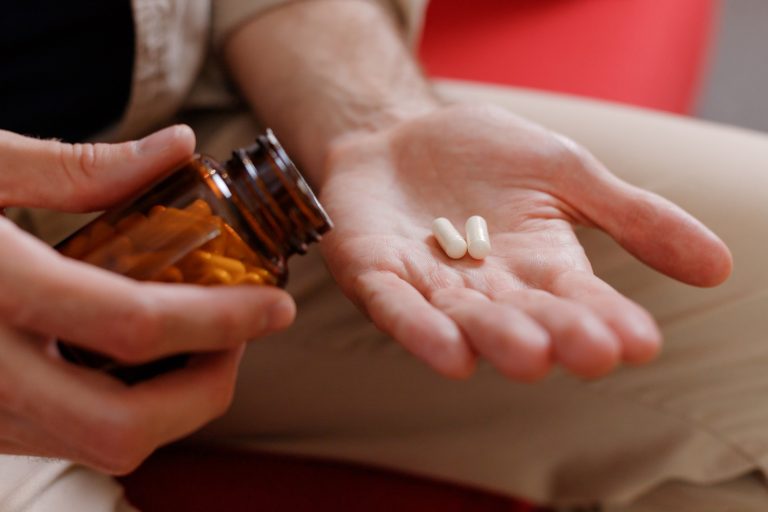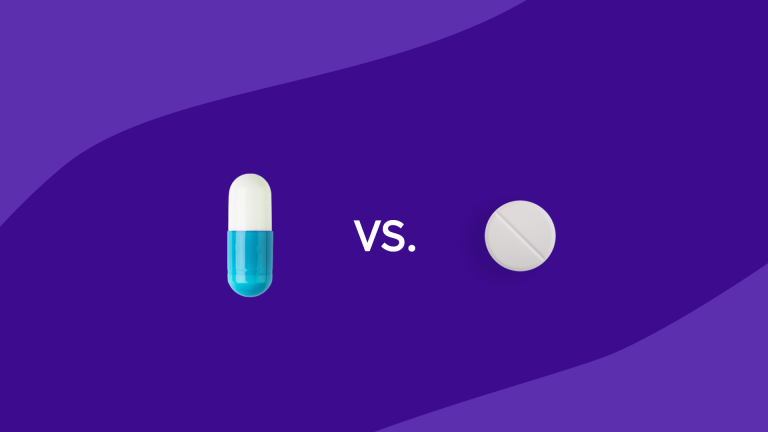Propranolol for Anxiety: What You Need to Know Before You Start
Propranolol is a heart medication (beta-blocker) that some doctors prescribe for anxiety inducing events. It helps to calm a racing heart and shaky hands, however, it doesn’t affect the thought-based or emotional aspects of anxiety.. While it can be helpful for some people, it’s not right for everyone and warrants careful medical supervision and consideration. … Read more

Reviewed by The PsychPlus Team
August 20, 2025

Propranolol is a heart medication (beta-blocker) that some doctors prescribe for anxiety inducing events. It helps to calm a racing heart and shaky hands, however, it doesn’t affect the thought-based or emotional aspects of anxiety.. While it can be helpful for some people, it’s not right for everyone and warrants careful medical supervision and consideration.
DISCLAIMER: This content is for informational purposes only and is not a substitute for medical advice. Propranolol is not FDA-approved for anxiety disorders. Any off-label use should only be considered under the direct supervision of a qualified healthcare provider.
What Is Propranolol?
Propranolol is a non-selective beta-adrenergic receptor antagonist, commonly known as a beta-blocker, originally introduced in the 1960s to treat cardiovascular conditions such as hypertension, angina, and tachycardia, especially in cases involving hyperthyroidism. By blocking both β1 and β2 receptors, propranolol inhibits the effects of catecholamines, such as adrenaline, leading to slower heart rate, lower blood pressure, and reduced cardiac workload.
Although its primary indications are cardiovascular, propranolol has gained attention for its off-label use in anxiety, particularly where physical symptoms, such as rapid heartbeat, hand tremors, and sweating, are prominent. Unlike traditional anti-anxiety medications that target the brain’s neurotransmitter systems, propranolol works peripherally, blunting the autonomic “fight-or-flight” response. This mechanism makes it useful in acute, situational anxiety, including public speaking, test-taking, or stage performance.
How It Became an Anxiety Helper
The potential of propranolol in anxiety management was first recognized in 1965, when researchers Turner and Granville-Grossman observed that patients taking propranolol for thyrotoxicosis also experienced reduced anxiety symptoms during stressful events [1]. This serendipitous finding prompted further research into its role in dampening the physical arousal associated with anxiety.
Since then, propranolol has been studied for performance-related anxiety, where its ability to reduce physiological arousal without affecting cognition or mood is especially beneficial. Evidence supports its use in short-term, event-specific contexts, where somatic symptoms are the primary barrier to functioning [2]. However, propranolol does not address the cognitive or emotional aspects of anxiety, and therefore is not suitable for all types of anxiety disorders.
The Important Fine Print
It’s important to note that Propranolol is not FDA-approved for treating anxiety disorders. Any use for anxiety is considered ‘off-label’ and should only be prescribed by a licensed healthcare provider based on clinical judgment. When used for anxiety, it is prescribed off-label, a legal and common practice in which a medication is used outside of its original approved indication based on clinical judgment.
Despite growing clinical interest and a significant increase in beta-blocker prescriptions for anxiety between 2003 and 2018, the evidence base remains limited. A 2023 systematic review and meta-analysis evaluated available trials and found no significant benefit of beta-blockers over placebo or benzodiazepines for treating disorders like social anxiety or panic disorder [3]. Most of the included studies had small sample sizes and methodological limitations, such as missing data and unclear risk of bias.
As a result, experts emphasize the need for larger, high-quality randomized controlled trials to clarify whether, and when, beta-blockers like propranolol are effective and appropriate for anxiety treatment.
How Does It Actually Help with Anxiety?
Targeting the Physical, Not the Psychological
Think about the last time you felt really anxious. Maybe your heart was pounding, your hands were shaking, or you were sweating. Propranolol mainly helps with those physical sensations.
Propranolol primarily works by addressing the physiological symptoms of anxiety, rather than the cognitive or emotional aspects. If you’ve ever experienced anxiety as a racing heart, trembling hands, or excessive sweating, you’re already familiar with the body’s “fight-or-flight” response. These symptoms are driven by surges of stress hormones, primarily adrenaline, that activate beta-adrenergic receptors in the heart and muscles.
While propranolol doesn’t interfere with anxious thoughts or underlying psychological patterns, it can blunt the body’s response, helping you feel more physically composed during high-stress situations.
Body-Mind Connection
When you’re anxious, your body releases stress hormones like adrenaline that stimulate beta-receptors in your heart and muscles, triggering the classic “fight-or-flight” symptoms: a pounding heart, shaky hands, and sweating.
Propranolol blocks these beta-receptors, dulling the effects of adrenaline. While it doesn’t address the psychological roots of anxiety, it can significantly reduce the physical symptoms, offering a sense of calm during high-stress moments.
How It Works: The Beta-Blocker Mechanism
Propranolol is a non-selective beta-adrenergic receptor antagonist, meaning it blocks both β1 and β2 receptors. By doing so, it inhibits the effects of adrenaline and noradrenaline, reducing heart rate, blood pressure, and other autonomic symptoms associated with acute anxiety. This makes it especially useful in situational anxiety, such as public speaking or performance anxiety, where the goal is to minimize physical arousal rather than address chronic worry or intrusive thoughts.
Onset and Duration of Effects
The onset of action typically occurs within 30 to 60 minutes after oral administration, with peak effects observed between 1 to 4 hours. Its therapeutic window generally lasts 3 to 6 hours, depending on dosage and individual metabolism. For this reason, propranolol is often taken shortly before a predictable anxiety-inducing event, rather than used as a daily medication.
When You’ll Feel It Working
You’ll usually start noticing the effects within 30 minutes to an hour after taking it. The strongest effects happen around 1-4 hours later, and they typically last about 3-6 hours. That’s why many people take it before they know they’ll be in a stressful situation.
When Might This Be Right for You?
Best Suited for “Event Anxiety”
Propranolol appears most helpful for what’s often called “event anxiety”, situations where you anticipate a specific, high-stress moment and want to manage the physical symptoms of anxiety ahead of time. This includes things like public speaking, job interviews, musical performances, or high-stakes exams, moments when your heart races, hands tremble, or your voice shakes.
This use is supported by a 2016 systematic review and meta-analysis of randomized controlled trials, which evaluated propranolol’s efficacy across several anxiety disorders [4]. The review included eight studies involving panic disorder, specific phobia, social phobia, and PTSD. The findings showed no strong evidence to support the routine use of propranolol for long-term anxiety treatment, but suggested its short-term use may benefit individuals facing acute, performance-based stress, particularly when physical symptoms are most disruptive.
Some notable examples of where propranolol has shown benefit include:
- Public speaking: Research has shown propranolol can reduce symptoms like trembling and rapid heartbeat, helping individuals stay composed in front of an audience.
- Musical performances: In a well-known study of musicians, propranolol significantly reduced nervousness, tremors, and sweating, and even improved performance quality, as rated by expert critics [5].
- Test anxiety: Students prone to exam-related anxiety performed better after taking propranolol, likely due to reduced physical arousal during testing [6].
While propranolol isn’t a cure for anxiety disorders, it may be a useful short-term tool for managing the body’s stress response in situations where physical symptoms stand in the way of performance or confidence.
Maybe Not the Best for Daily Worry
For individuals with generalized anxiety disorder (GAD), characterized by persistent, excessive worry across multiple domains of life, propranolol is generally not considered a first-line treatment. Unlike selective serotonin reuptake inhibitors (SSRIs) or cognitive behavioral therapy (CBT), propranolol does not address the psychological or cognitive components of chronic anxiety. Instead, it acts peripherally, targeting the somatic symptoms of acute stress.
A major systematic review and meta-analysis conducted by Steenen et al. (2016) found that while propranolol shows limited efficacy for long-term anxiety conditions such as GAD or panic disorder, it is more effective in performance-related anxiety, where the dominant symptoms are physiological, including tremors, sweating, and tachycardia [4]. These findings have been supported by earlier and more recent studies [2,7], which consistently indicate that propranolol’s clinical utility is best reserved for short-term, situational use, rather than for ongoing anxiety management.
In one controlled trial evaluating daily propranolol use in individuals with chronic anxiety, modest improvements were observed, but not to a degree that would justify its use as a routine or primary treatment approach [7].
How People Actually Use It
- Before a stressful event: For situational anxiety, propranolol is typically taken 10–40 mg about 30 to 60 minutes prior to the event. In some cases, the dose may be increased up to 60 mg, but higher doses should be used cautiously and only under medical supervision.
- For ongoing support: While a daily dosing strategy (usually starting at 40 mg and sometimes increasing to 120 mg in divided doses) is occasionally used, this is not common practice for anxiety and is generally limited to cases where persistent physical symptoms interfere with function despite psychological interventions. One controlled study showed modest improvement in individuals with chronic anxiety who used propranolol daily, but findings did not support it as a primary or first-line treatment. [7].
What It Actually Feels Like
Many people describe propranolol’s effects like this:
“My mind was still nervous about the presentation, but my body felt calm. My heart wasn’t racing, and my hands weren’t shaking, so I could actually focus on what I needed to do.”
This reflects how propranolol helps interrupt the body’s fight-or-flight stress response. By blocking beta-adrenergic receptors, it reduces the physical effects of adrenaline, such as elevated heart rate and trembling, helping the body shift out of a heightened stress state even when anxiety-inducing thoughts remain.
The Not-So-Fun Stuff (Side Effects)
What You Might Notice
Common side effects include fatigue, dizziness upon standing, cold hands and feet, and slower heart rate. Some people also experience vivid dreams or difficulty sleeping.
Most side effects tend to diminish as your body adjusts to the medication. In clinical trials, the most frequently reported adverse effects were dizziness, fatigue, and insomnia, though these symptoms can sometimes overlap with anxiety itself [7].
Who Shouldn’t Take This
Propranolol is not safe for everyone and should be avoided or used with extreme caution in certain groups:
- Asthma or reactive airway diseases: Propranolol’s beta-2 blockade can cause bronchoconstriction, potentially triggering asthma attacks or worsening chronic obstructive pulmonary disease (COPD).
- Certain heart conditions: Individuals with severe bradycardia (slow heart rate), second- or third-degree heart block, or cardiogenic shock should not take propranolol, as it can further suppress cardiac conduction and contractility, leading to dangerous complications.
- Hypotension: People with very low blood pressure risk excessive drops in blood pressure, which can cause dizziness, fainting, or falls.
- Severe peripheral arterial disease: Beta-blockers may worsen symptoms of poor circulation in extremities.
- People with diabetes: Propranolol can mask classic hypoglycemia symptoms such as rapid heartbeat and tremors, making it harder to detect low blood sugar episodes. Caution and close blood glucose monitoring are essential.
- Pregnant or breastfeeding individuals: Propranolol crosses the placenta and enters breast milk. It may increase the risk of fetal growth restriction, neonatal bradycardia, and hypoglycemia in the infant. Use only if clearly needed and under close medical supervision.
- Older adults: Aging slows drug metabolism and clearance, increasing the risk of accumulation and side effects. Older patients often require lower doses and careful monitoring for fatigue, dizziness, and bradycardia.
- Liver or kidney impairment: Since propranolol is metabolized in the liver and excreted by the kidneys, severe hepatic or renal dysfunction may necessitate dose adjustments.
Mixing It with Other Things
- Alcohol: Combining propranolol with alcohol can cause excessive blood pressure lowering, resulting in dizziness, lightheadedness, or fainting, especially when standing up quickly.
- Other blood pressure or heart medications: Concurrent use with calcium channel blockers, clonidine, or digoxin can increase the risk of bradycardia or heart block. Always disclose all prescription medications to your doctor.
- Certain antidepressants and antipsychotics: Some can alter propranolol metabolism or increase sedation.
- Over-the-counter supplements: Herbal supplements like ginseng, St. John’s wort, or hawthorn may interact with propranolol, potentially affecting its blood pressure or heart rate effects.
- Beta-agonists: Medications such as albuterol (used for asthma) may have reduced effectiveness when taken with propranolol due to receptor blockade.
Because of these potential interactions, it’s critical to inform your healthcare provider about every medication, supplement, and vitamin(s) you are taking before starting propranolol and whenever you make changes.
How Does This Compare to Other Options?
Anxiety Medications You Might Know
Antidepressants (like Zoloft): These work on your brain chemistry and help with both the worried thoughts and physical symptoms. They take weeks to kick in but can be really effective for ongoing anxiety.
Anti-anxiety medications (like Xanax): These work fast for both mental and physical symptoms but can be habit-forming, so doctors are careful about prescribing them long-term.
Propranolol: Works quickly like Xanax but mainly for physical symptoms, and it’s not habit-forming in the same way.
When Doctors Might Suggest Propranolol
Your doctor might bring up propranolol if:
- You mainly experience physical anxiety symptoms
- You need something that works relatively quickly for specific anxiety situations
- Other anxiety medications haven’t worked well for you
- You can’t take other types of anxiety medication for some reason
But here’s the thing: Recent research shows mixed results about how well beta blockers actually work for anxiety. The most comprehensive review found “no evidence for a beneficial effect of beta-blockers compared with either placebo or benzodiazepines in patients with social phobia or panic disorder” [3]. However, some older studies did show benefits for specific situations like performance anxiety [3,6,8]
Your Most Common Questions
How fast does it work?
Most people start feeling calmer within 30-60 minutes, with the strongest effects around 1-4 hours after taking it.
Can I take it every day?
Some people do, but it’s more commonly used just when needed for specific stressful situations. Daily use needs more careful monitoring.
What happens if I drink while taking it?
Don’t do this! Avoid combining propranolol with alcohol, as this may lead to excessive drops in blood pressure, resulting in dizziness, fainting, or falls.
Can I take it with my antidepressant?
Maybe, but your doctor needs to coordinate this carefully since both can affect your heart.
When to Call Your Doctor Right Away
Don’t mess around if you experience:
- Your heart beating really slowly (under 50 beats per minute)
- Feeling like you might faint
- Trouble breathing
- Chest pain
- Your legs or feet swelling up
Important Safety Stuff
Never just stop taking propranolol suddenly if you’ve been taking it regularly. Your doctor will help you gradually reduce the dose to avoid problems like your blood pressure bouncing back up.
Always take it exactly as prescribed, don’t skip doses if you’re on a daily schedule, and keep your doctor and therapist in the loop about how you’re feeling.
The Real Talk
Propranolol can definitely help some people feel more physically calm during stressful situations. If you’re someone who experiences a racing heart and shaky hands but your mind stays pretty clear, it might be worth discussing with a doctor.
But it’s not a magic bullet for anxiety. Recent evidence suggests its overall benefit may be limited for chronic anxiety disorders, though it can be helpful in specific, situational cases. [3]. The evidence is strongest for specific performance anxiety situations, but even then, the overall quality of research is limited [4]. And remember, because it’s not FDA-approved for anxiety, its use in this context is considered ‘off-label’, a legal but clinically guided decision.”
The bottom line: If anxiety is affecting your life, the best thing you can do is talk to someone who can help you explore all your options. That might include propranolol, but it could also mean therapy, other medications, or lifestyle changes that address anxiety in various physiological ways, including quality sleep, a balanced nutrient dense diet, exercise and regular sunlight and nature exposure [9-13].
Want to explore what might work for you? A PsychPlus provider can help you figure out whether propranolol or other treatments make sense for your specific situation. They’ll consider your health history, what kind of anxiety you’re dealing with, and what your goals are. Book a consultation to get personalized guidance that actually fits your life.
References
[1] Turner, P., & Granville-Grossman, K. L. (1965). Effect of adrenergic receptor blockade of the tachycardia of thyrotoxicosis and anxiety state. The Lancet, 2(7420), 1316-1318. https://pubmed.ncbi.nlm.nih.gov/4165805/
[2] Szeleszczuk, Ł., & Frączkowski, D. (2022). Propranolol versus other selected drugs in the treatment of various types of anxiety or stress, with particular reference to stage fright and post-traumatic stress disorder. International Journal of Molecular Sciences, 23(17), 10099. https://pubmed.ncbi.nlm.nih.gov/36077489
[3] Archer, C. S., Wiles, N. J., Kessler, D. S., Turner, K. M., & Caldwell, D. M. (2025). Beta-blockers for the treatment of anxiety disorders: A systematic review and meta-analysis. Journal of Affective Disorders, 368, 90-99. https://pubmed.ncbi.nlm.nih.gov/39271062/
[4] Steenen, S. A., van Wijk, A. J., van der Heijden, G. J., van Westrhenen, R., de Lange, J., & de Jongh, A. (2016). Propranolol for the treatment of anxiety disorders: Systematic review and meta-analysis. Journal of Psychopharmacology, 30(2), 128-139. https://pubmed.ncbi.nlm.nih.gov/26487439/
[5] Brantigan, C. O., Brantigan, T. A., & Joseph, N. (1982). Effect of beta blockade and beta stimulation on stage fright. American Journal of Medicine, 72(1), 88-94. https://pubmed.ncbi.nlm.nih.gov/6120650/
[6] Brewer, C. (1972). Beneficial effect of beta-adrenergic blockade on “exam nerves.” The Lancet, 2(7774), 435. https://pubmed.ncbi.nlm.nih.gov/4115260/
[7] Kathol, R. G., Noyes, R., Slymen, D. J., Crowe, R. R., Clancy, J., & Kerber, R. E. (1980). Propranolol in chronic anxiety disorders: A controlled study. Archives of General Psychiatry, 37(12), 1361-1365. https://pubmed.ncbi.nlm.nih.gov/7447618/
[8] Clark, D. B., & Agras, W. S. (1991). The assessment and treatment of performance anxiety in musicians. American Journal of Psychiatry, 148(5), 598-605. https://pubmed.ncbi.nlm.nih.gov/2018160/
[9] Chellappa SL, Aeschbach D. Sleep and anxiety: From mechanisms to interventions. Sleep Med Rev. 2022 Feb;61:101583. doi: 10.1016/j.smrv.2021.101583. Epub 2021 Dec 8. PMID: 34979437. https://pubmed.ncbi.nlm.nih.gov/34979437/
[10] Aucoin M, LaChance L, Naidoo U, Remy D, Shekdar T, Sayar N, Cardozo V, Rawana T, Chan I, Cooley K. Diet and Anxiety: A Scoping Review. Nutrients. 2021 Dec 10;13(12):4418. doi: 10.3390/nu13124418. PMID: 34959972; PMCID: PMC8706568. https://pubmed.ncbi.nlm.nih.gov/34959972/
[11] Coles ME, Schubert JR, Nota JA. Sleep, Circadian Rhythms, and Anxious Traits. Curr Psychiatry Rep. 2015 Sep;17(9):73. doi: 10.1007/s11920-015-0613-x. PMID: 26216591. https://europepmc.org/article/med/26216591
[12] Anderson E, Shivakumar G. Effects of exercise and physical activity on anxiety. Front Psychiatry. 2013 Apr 23;4:27. doi: 10.3389/fpsyt.2013.00027. PMID: 23630504; PMCID: PMC3632802. https://pmc.ncbi.nlm.nih.gov/articles/PMC3632802/
[13] Paredes-Céspedes DM, Vélez N, Parada-López A, Toloza-Pérez YG, Téllez EM, Portilla C, González C, Blandón L, Santacruz JC, Malagón-Rojas J. The Effects of Nature Exposure Therapies on Stress, Depression, and Anxiety Levels: A Systematic Review. Eur J Investig Health Psychol Educ. 2024 Mar 7;14(3):609-622. doi: 10.3390/ejihpe14030040. PMID: 38534901; PMCID: PMC10969128. https://pubmed.ncbi.nlm.nih.gov/38534901/
Find a mental health care provider near you
Learn about the conditions we treat


